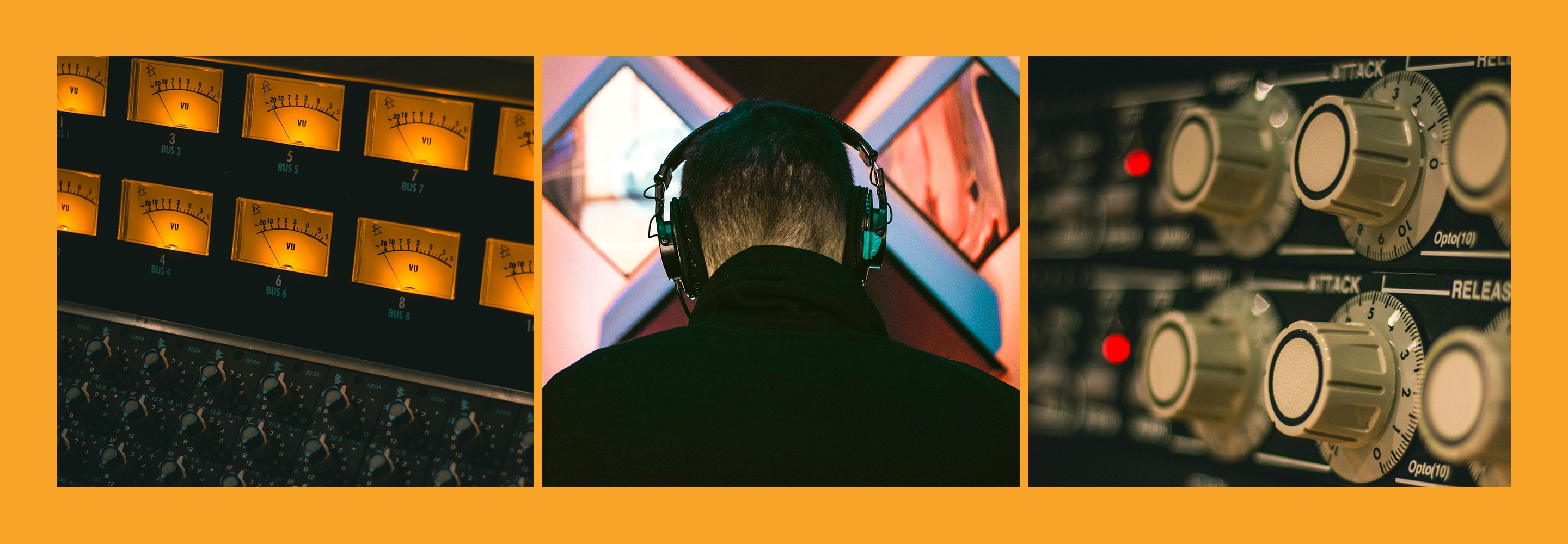
A LUFS and tonal analysis of 10 top-charting dance and electronic songs
Are electronic and dance hits still pushing extreme loudness? This in-depth LUFS and tonal analysis of Billboard chart-toppers reveals some surprising trends.
In some of my other recent analysis articles we’ve seen a surprisingly constant trend of most commercial releases being mastered to around -8.3 LUFS, ±1 LU. However, if there’s one group of genres that's still known for "needing" to be really loud – say, north of -6 LUFS – it’s those that fall under the umbrella of electronic and dance music.
To investigate this, this month I decided to take a look at some of the top Billboard dance and electronic songs, and see where they’re landing. The results may surprise you!
Follow along with this analysis using


RX 11 Advanced
What are we analyzing?
The music for this analysis came from Billboard’s “Hot Dance/Electronic Songs” chart during the week of March 22nd. As of this writing though, the top five haven’t changed, and all the songs are still on the chart somewhere.
I wanted to balance analyzing a decent number of songs with being able to offer some reflection on individual songs. To do this I came up with the following criterion: analyze songs that are in the top five, or have peaked at number five, or higher. This left me 10 songs, all of which I’ve written at least a little something about below, along with providing some vital credits, stats, and images showing a short-term LUFS trace and the tonal balance average of the full song.
Song analysis process
There are a few common questions people have when they read one of my analysis articles, so let’s cover those up front:
- What sources were used for analysis? For each of these songs, I purchased and downloaded the lossless, high resolution – when available – file from the Qobuz store. This ensures that no streaming codecs or other hiccups get in the way. In a few, rare instances when a title isn’t available on the Qobuz store I will stream the lossless version from Apple, at the native sample rate, with loudness normalization turned off.
- Do the numbers include any normalization? No. All analysis is done at the full, mastered level. That said, music discovery trends tell us that something like 85% of casual listeners listen with normalization turned on. So, just because something is mastered “loud” doesn’t mean that’s how people will experience it next to something “less loud.” In fact, in a predominantly loudness normalized playback world, I would argue that raw LUFS measurements tell us more about density than they do “loudeness” – but that’s an article for another time.
- What about Atmos? Don’t those need to be at -18 LUFS? Yes, the loudest Atmos mix on an album needs to not exceed -18 LUFS, integrated. In fact, in some cases where both Atmos and stereo mixes of a song exist, we have an unusual and interesting opportunity to compare more and less dynamic versions of a song. For this analysis though, only stereo versions were used.
So, in short, this analysis uses downloaded lossless files with no normalization – or any other processing – applied. They are as close to what the mastering engineer was listening to as we can get!
The music
If you’d like to listen along to the songs as you read, here’s a playlist with all songs, in order. Let’s dive in.
1. “Miles On It” by Marshmello & Kane Brown
Producer(s): Marshmello, Connor McDonough, Digital Farm Animals
Mixing: Manny Maroquin
Mastering: Zach Pereyra
Peak Position: 1
Weeks on chart: 45
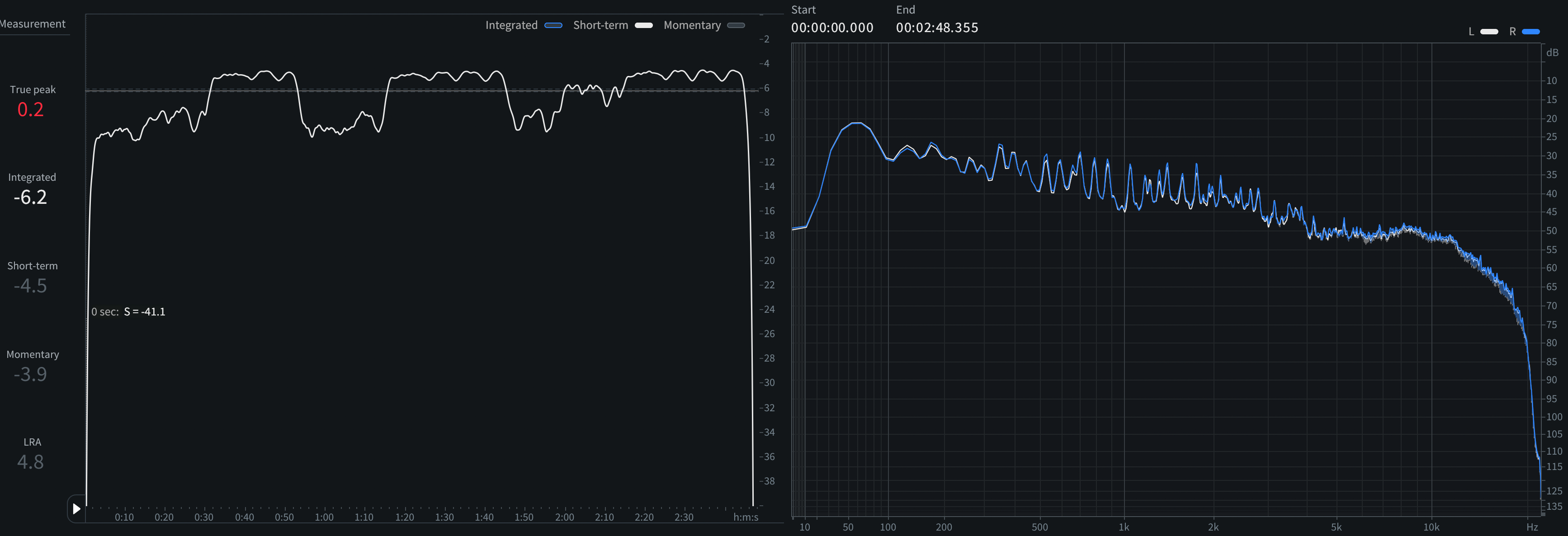
Short-term LUFS and spectrum of “Miles On It”
True Peak: 0.22 dBTP
Sample Peak: 0.00 dBFS
Int. Loudness: -6.2 LUFS
Loudness Range: 4.8 LU
I have to be honest, the country/house mashup genre doesn’t speak to me, but at number one on the chart – and charting for nearly a year – “Miles On It” clearly shows I’m in the minority. That said, like any good mastering engineer, I can set personal preferences aside and listen critically to things like tonality, dynamism, etc.
There are things about this song that work well. While there’s not a lot of low-end in the verses, that’s an arrangement choice which – at least potentially – could help the choruses sound even bigger.
There is a slightly odd artifact on the guitar that comes in at 1:06 which sounds almost a bit like comb filtering, and which I don’t hear on the guitar the rest of the time.
The main thing to highlight in this song is the level of the choruses, and how it was achieved. There's good, and there’s loud, and then there’s good and loud. Unfortunately, this falls shy of that last one. The raw distortion in the choruses, which hits upwards of -4.5 LUFS, short term – detracts from the listening experience.
Whether this was a part of the mix or mastering process, we can’t know for sure. What we do know is that you absolutely can hit those sorts of levels very cleanly – check out number nine on the list for an example.
The chorus levels feel like a missed opportunity. Whether it was just part of the mix that came forward in mastering, or it was a result of trying to push the song beyond its latent loudness potential in mastering, it’s enough for me to wish for more out of the mastered sound.
2. “The Days” by CHRYSTAL
Producer(s): Chrystal
Mixing: Chrystal
Mastering: Chrystal
Peak Position: 2
Weeks on chart: 15
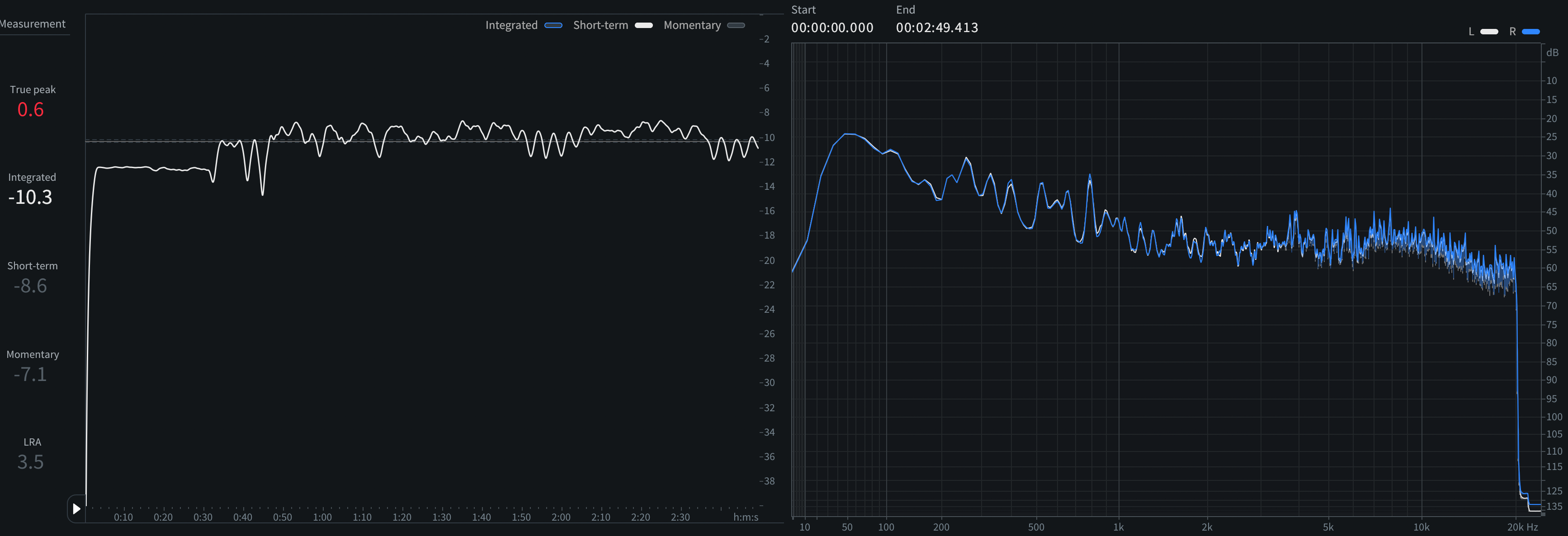
Short-term LUFS and spectrum of “The Days”
True Peak: 0.61 dBTP
Sample Peak: -0.20 dBFS
Int. Loudness: -10.3 LUFS
Loudness Range: 3.5 LU
Completely self-produced, mixed, and mastered, we almost couldn’t have a bigger contrast between positions one and two on the chart. “The Days” is hardly a peak-hour floor-filler. Instead, it’s a sparsely arranged slow burn that could easily be the bridge between a warmup and opener type set.
At a more conservative -10.3 LUFS, integrated, there’s ample room for the kick to really punch, the classic M1 organ to give you house vibes deep in your soul, and the bass to clearly resonate all the way down to 35 Hz.
One interesting technical tidbit though: although being a 48 kHz file, the frequency content – which cuts off hard above 20.1k – and slightly haphazard looking peak levels suggest to me that this may have been mixed and mastered at 44.1k and later resampled to 48k.
3. “Forever Young” by David Guetta, Alphaville & Ava Max
Producer(s): David Guetta, Timofey Reznikov, Jakke Erixson, Tor Eimon
Mixing: Timofey Reznikov
Mastering: Timofey Reznikov
Peak Position: 2
Weeks on chart: 21
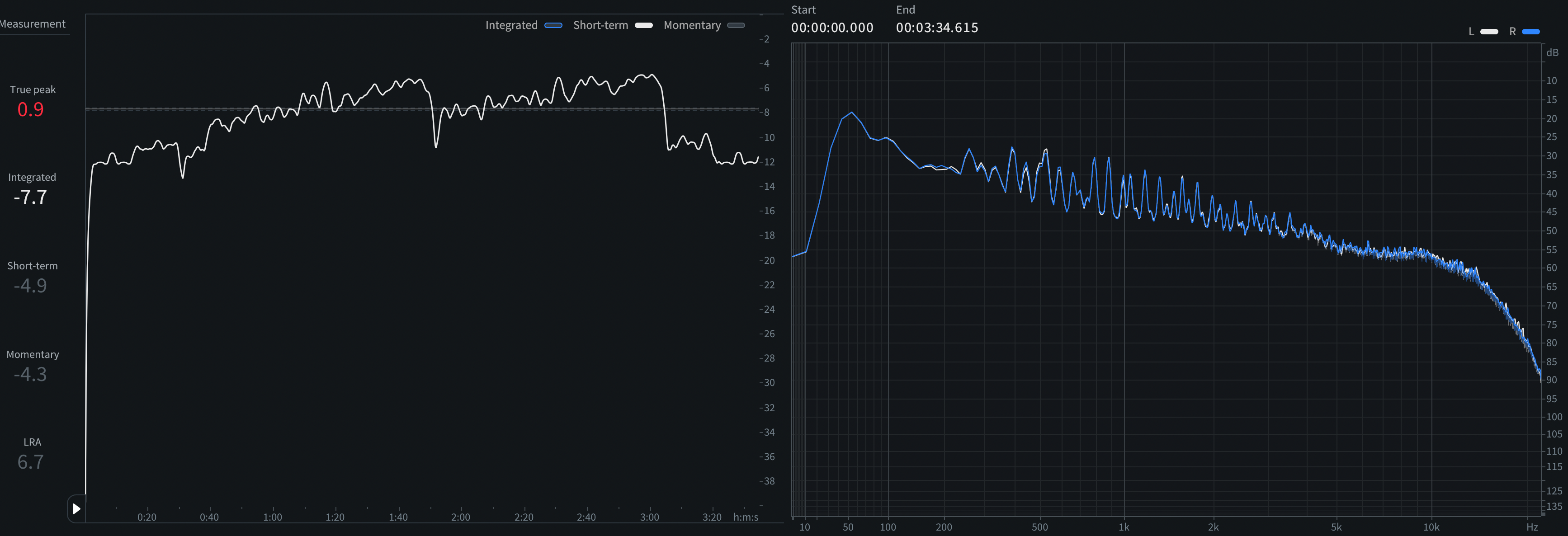
Short-term LUFS and spectrum of “Forever Young”
True Peak: 0.92 dBTP
Sample Peak: -0.23 dBFS
Int. Loudness: -7.7 LUFS
Loudness Range: 6.7 LU
Ahh yes, classic big-room Guetta. If you want an example of that “good and loud” I was talking about earlier, this is at least one style of it. The choruses hang out around -5.5 LUFS, and yet feel much cleaner than the choruses in “Miles On It.”
There are two things that I think contribute to this, and – in no surprise to mastering engineers – they’re both production/mixing things. First, the classic sidechain pumping around the kick leaves plenty of space for it. This means the sound can be very dense while still maintaining some definition around the low transients – usually the first casualties of limiting.
Second, the synth choices are quite buzzy, which makes them good at masking at least a bit of distortion. I’d actually hardly call this master distortion free, but what that distortion does is wear a very convincing suite of camouflage.
4. “Slow Motion” by Marshmello X Jonas Brothers
Producer(s): Marshmello, Connor McDonough, Digital Farm Animals, Earwulf
Mixing: Manny Maroquin
Mastering: Zach Pereyra
Peak Position: 4
Weeks on chart: 8
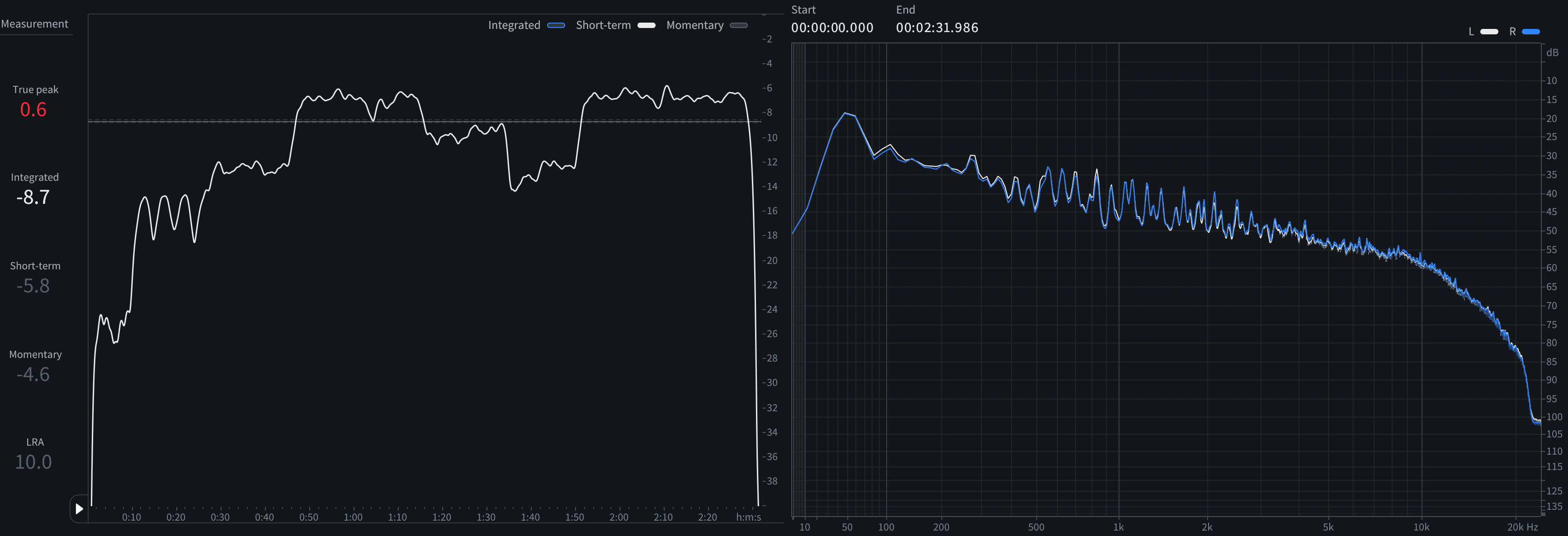
Short-term LUFS and spectrum of “Slow Motion”
True Peak: 0.57 dBTP
Sample Peak: -0.20 dBFS
Int. Loudness: -8.7 LUFS
Loudness Range: 10.0 LU
Another entry from the Marshmello team in the top five, this one fares a little better, and if I had to include one in a playlist of references, this would be it. While it is about 2.5 LU softer, a lot of that is down to the more progressive, building arrangement – the loud moments are only a little over 1 dB softer than those in “Miles On It.”
Still, listen for a bit of distortion to creep into the bass on those lowest notes in particular. Also, compare the tonal distribution screenshot to that of “Miles On It” and pay special attention to the bass below 100 Hz and that between about 100 and 300 Hz.
5. “Neverender” by Justice & Tame Impala
Producer(s): Justice
Mixing: Justice, Vincent Taurelle
Mastering: Damien Quintard
Peak Position: 5
Weeks on chart: 30
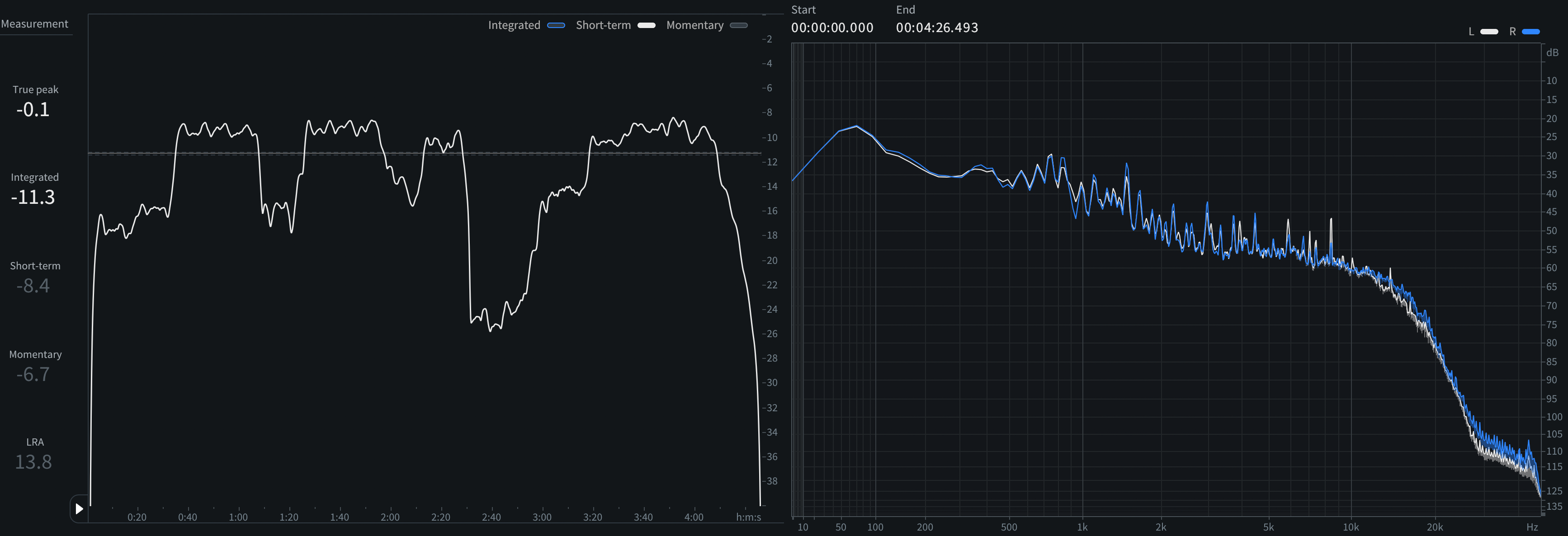
Short-term LUFS and spectrum of “Neverender”
True Peak: -0.09 dBTP
Sample Peak: -0.10 dBFS
Int. Loudness: -11.3 LUFS
Loudness Range: 13.8 LU
The only truly hi-res entry in our list, this one has the sonics to match. With massive low end and drums that really punch into the available headroom, this is a song that rewards turning it up and doesn’t get harsh or fatiguing when you do.
Pay attention to the stereo imaging, too, both in headphones and on speakers. On headphones, the intro vocal achieves the rather neat trick of feeling like it’s actually out in front of you rather than inside your head, and on both cans and speakers, the bass feels wide without actually being that wide down low.
While it may not be the most club-oriented song in this list, after 32 weeks on the chart and holding steady at no. five, this song – along with “The Days” – make it harder to argue that you can’t be successful in dance music if you’re not up near -6 LUFS.
Also, this one is totally on my reference tracks playlist.
6. “Move” by Adam Port & Stryv Featuring Malachiii
Producer(s): Adam Port, STRYV
Mixing: Jon Castelli
Mastering: Dale Becker
Peak Position: 4
Weeks on chart: 39
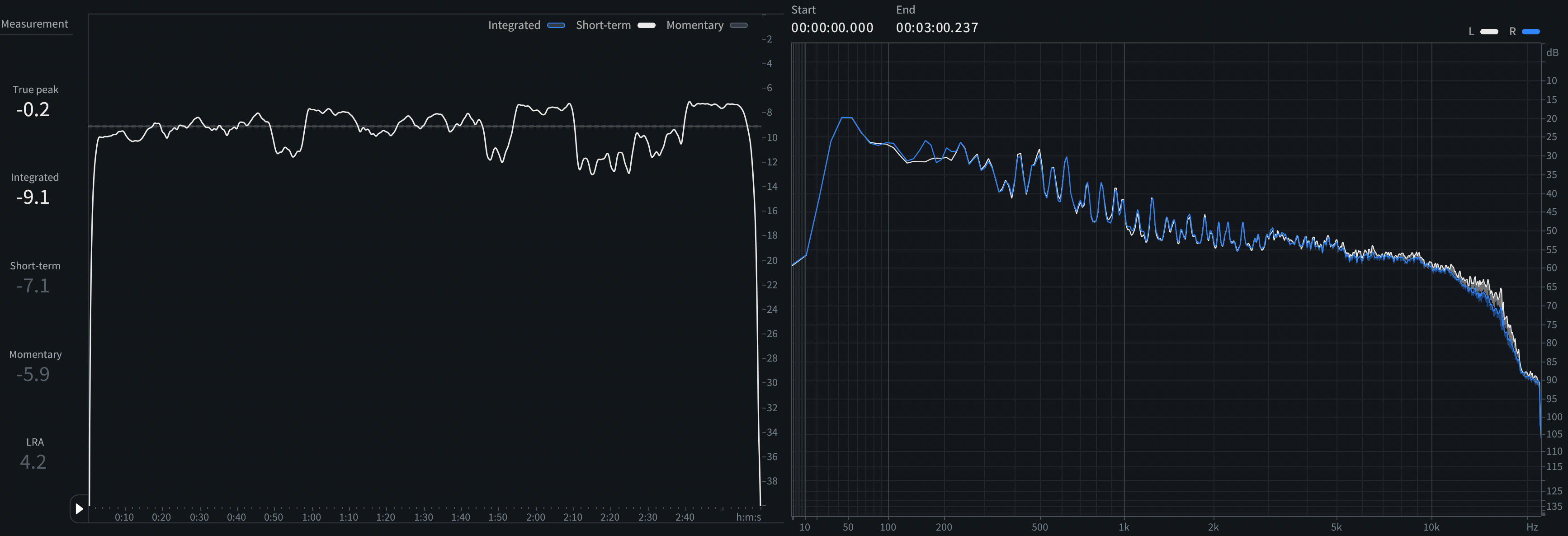
Short-term LUFS and spectrum of “Move”
True Peak: -0.23 dBTP
Sample Peak: -0.23 dBFS
Int. Loudness: -9.1 LUFS
Loudness Range: 4.2 LU
Continuing with that theme, “Move” has been on the charts for over 40 weeks, peaking at no. four and clocks in at “only” -9.1 LUFS integrated. Sure, it’s got deeper vibes and probably doesn’t have quite the same loudness expectations around it as a Guetta or Marshmello track, but without a tone of effort I certainly can get it a dB or two louder.
Does that mean it should have been a dB or two louder though? Heck no! When pushed in that way the sound gets tighter and denser, and you know what it doesn’t do as much of? Move. What’s the name of the song? “Move.” That’s important, and it’s why we have to tap into our musical intuition as engineers. The lyrics of this song are all about movement, and so the sonics should reflect that.
7. “Beautiful People” by David Guetta & Sia
Producer(s): David Guetta, StarGate, Timofey Reznikov
Mixing: Timofey Reznikov
Mastering: Timofey Reznikov
Peak Position: 8
Weeks on chart: 1

Short-term LUFS and spectrum of “Beautiful People”
True Peak: 1.50 dBTP
Sample Peak: -0.28 dBFS
Int. Loudness: -7.7 LUFS
Loudness Range: 5.8 LU
At number eight on the chart – and down to number 12 after only 3 weeks – this one is a bit of an outlier. However, it presents a unique opportunity as there are both stereo and ATMOS mixes of it. The stereo mix has a peak-to-loudness ratio – or PLR – of 7.5 dB while the ATMOS mix’s PLR is nearly double that at 14.7 dB.
Being able to compare more and less dynamic versions of a song is not something we have historically had lots of opportunities to do. Remasters provide one avenue, but there, you’re often shoehorning older music that was not conceived of with high loudness in mind into a more modern aesthetic. Here though, we have something that was conceived of with high loudness in mind, and the opportunity to hear what it sounds like when mixed and mastered with higher dynamism.
If you’re up for the routing challenge, see if you can record both the stereo and binaural ATMOS render, bring them into RX, use the Loudness Control module to match the stereo loudness to that of the ATMOS, and have fun doing an A/B comparison!
8. “Dreamin (feat. Daya)” by Dom Dolla
Producer(s): Dom Dolla, TimFromTheHouse
Mixing: Dom Dolla
Mastering: Wayne Sunderland
Peak Position: 5
Weeks on chart: 5
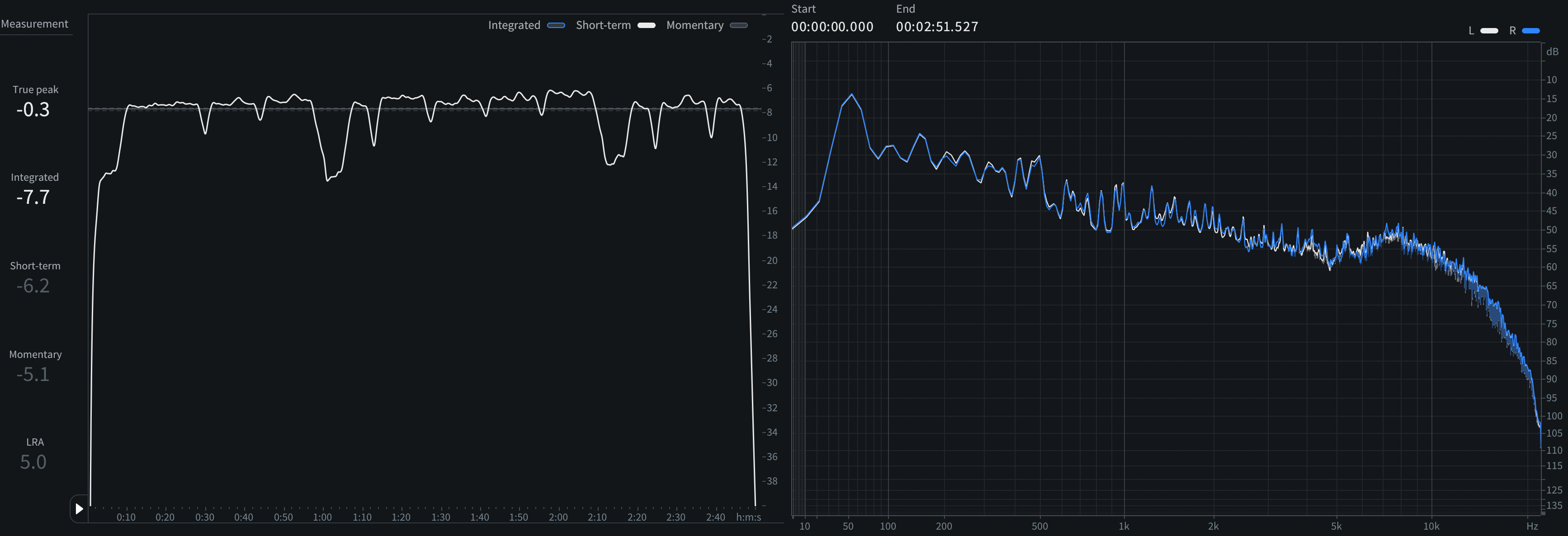
Short-term LUFS and spectrum of of “Dreamin”
This is another example of “good and loud.” At -7.7 LUFS integrated this is no slouch, and yet it manages to still feel clean and punchy. It’s also the track I think has maybe the most room for improvement at the mastering stage. Here are three things I would consider if mastering this song:
Sibilance: The vocal gets strident in the 5-8 kHz region, especially when it’s on its own. A single band of dynamics could certainly help smooth that out, but equally, so could some level automation, which brings me to…
Dynamic inversions: A dynamic inversion is when something that should sound soft ends up sounding louder than the things that sound loud. It’s subtle here, but those solo vocal sections – intro, 0:58, and 2:20 – end up feeling about 2 dB louder than everything around them. Most often this happens due to bus compression or heavy limiting. If you like the sound of that compression, you can easily automate the level of the vocal sections down post compression.
Tonal balance: Some little moves here, coupled with the above mentioned automation – do a few interesting things. First, things just feel a bit fuller and more well rounded to me. Second, the song feels a touch louder during the full sections, and more balanced between the solo vocal and full sections, and third it measures 0.1 LU lower, meaning it would get turned down slightly less on streaming.
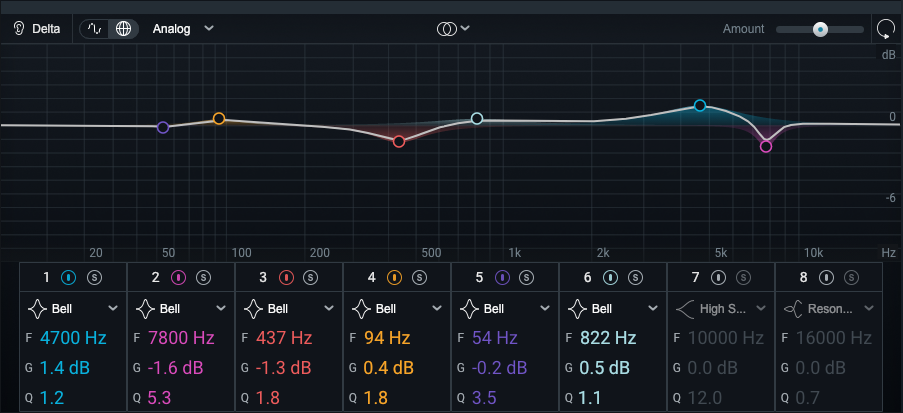
“Dreamin” EQ
Now, this is not to cast any shade on Wayne Sunderland – or Dom Dolla, I don’t know what their discussions or goals were – it’s just how I might approach it.
9. “Hypnotized” by Anyma & Ellie Goulding
Producer(s): Cassian, Anyma
Mixing: Cassian
Mastering: Cassian
Peak Position: 5
Weeks on chart: 6
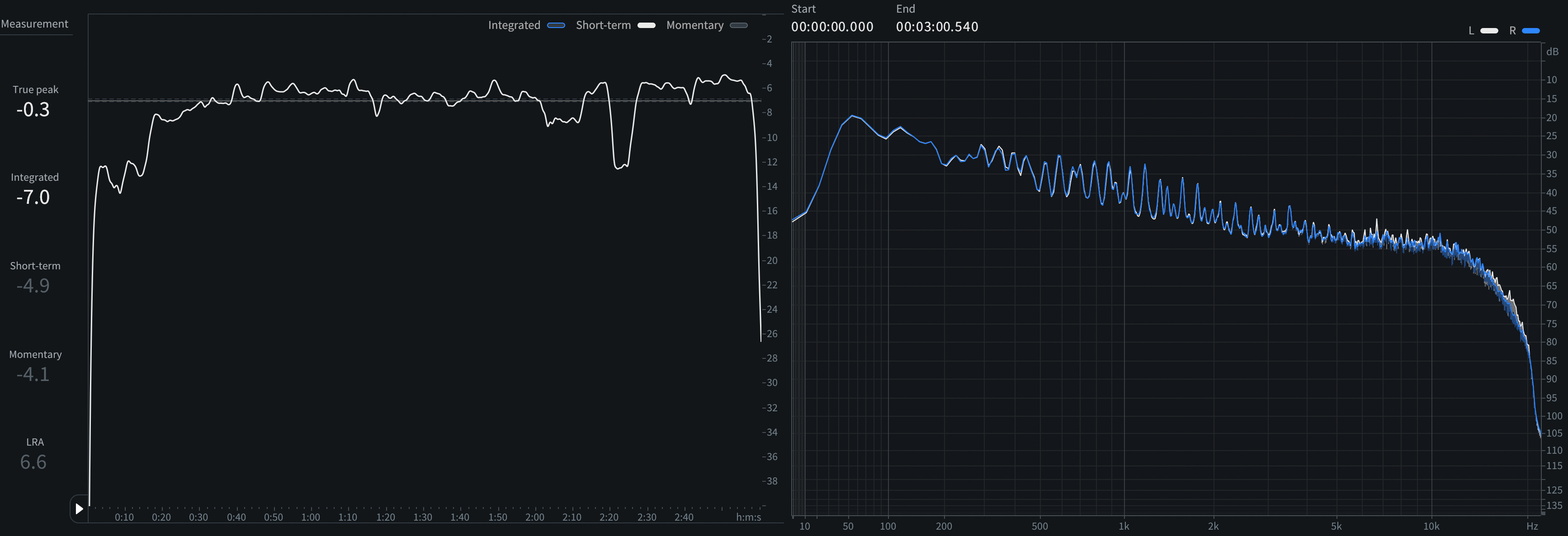
Short-term LUFS and spectrum of “Hypnotized”
True Peak: -0.29 dBTP
Sample Peak: -0.30 dBFS
Int. Loudness: -7.0 LUFS
Loudness Range: 6.6 LU
Here’s another “good and loud” example. A few comparisons to check out against other songs on this list.
- The final section gets just as loud as – if not perceptibly louder than – “Miles On It” but feels much cleaner
- The vocal breakdown at 2:18 feels much more well balanced with sections to either side of it, particularly the vocal that comes back in at 2:41
- Great tonal balance.
10. “Focus (feat. CLOVES)” by John Summit
Producer(s): John Summit, Frederik Geuze
Mixing: Cassian
Mastering: Cassian
Peak Position: 5
Weeks on chart: 8

Short-term LUFS and spectrum of “Focus”
True Peak: -0.28 dBTP
Sample Peak: -0.30 dBFS
Int. Loudness: -7.0 LUFS
Loudness Range: 5.4 LU
Rounding us out is “Focus” by John Sumit. I could say most of the same things about this as I did for “Hypnotized,” and that may come as no surprise given that Cassian is responsible for the mix and master of both. If this genre speaks to you, you could do a lot worse than to have either, or both of these in your reference tracks playlist!
Meta-analysis and reflection
So, what can we take from these songs? First, good, and loud, don’t always go hand in hand. Certainly they can, but we have some very successful songs down around -10 or -11 LUFS. I view this not as a sign that we should be trying to achieve any one number for our masters in this genre – or any other – but rather as encouragement that the number doesn’t really matter. It can sound good loud and dense; it can sound good softer and dynamic.
This means you have the freedom to choose the level and dynamic presentation that works best for your music and not worry too much about it not being “loud enough.”
| 2024 Trends | Hot Dance/Electronic | |
| Avg LUFS, Int | -8.3, ±1 | -8.3 |
| Max LUFS, Int | -6.0 | -6.2 |
| Min LUFS, Int | -11.1 | -11.3 |
| Avg LUFS, S-T | -6.1, ±0.99 | -6.1 |
| Max LUFS, S-T | -3.6 | -4.5 |
| Min LUFS, S-T | -7.8 | -8.6 |
| Avg LRA | 5.5, ±1.5 | 6.6 |
| Max LRA | 10.8 | 13.8 |
| Min LRA | 1.4 | 3.5 |
Second, if we look at our numbers, above, and compare them to those from our 2024 trends analysis, out pops that -8.3 number again!
Full disclosure, if you analyze the full chart like my friend Vespers did – keep an eye out for his video – that average does come up 0.5 dB to -7.8.
However, there are two outliers at about -2.5 LUFS integrated (!) that pull that number up. You know that completely blown out, distorted sound you hear in TikToks? Yeah, that’s why they’re on the chart.
Use this analysis to inform your mastering decisions
We hope that this analysis helps you in your dance and electronic masters. Keep an eye out for more analyses down the road, and be sure to let us know over on Instagram if there are any particular charts, genres, or songs you’d like to see analyzed.


